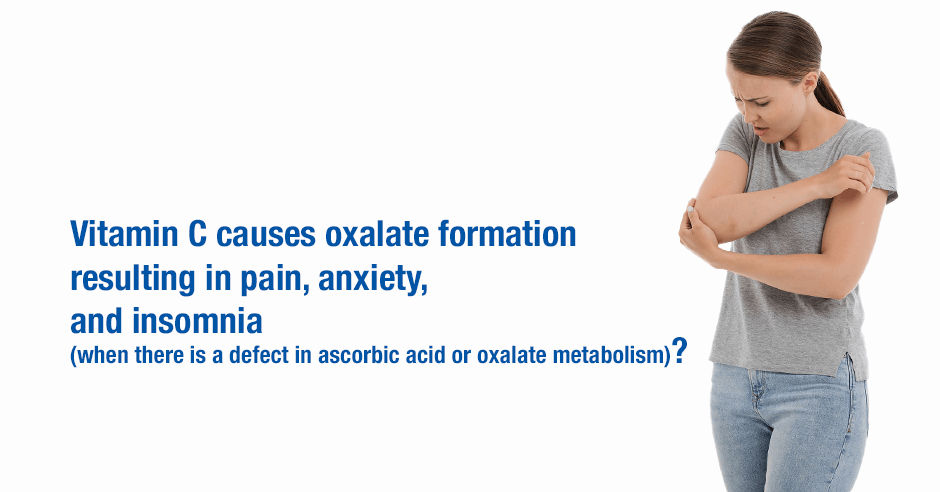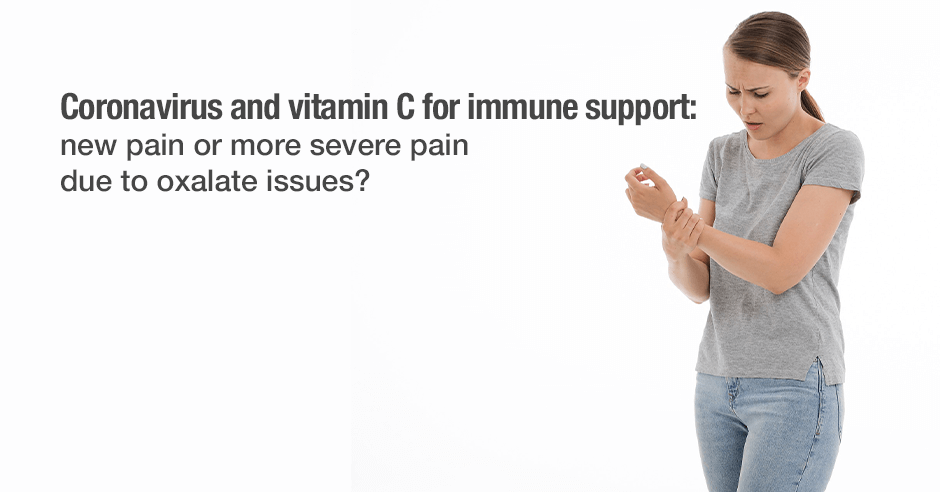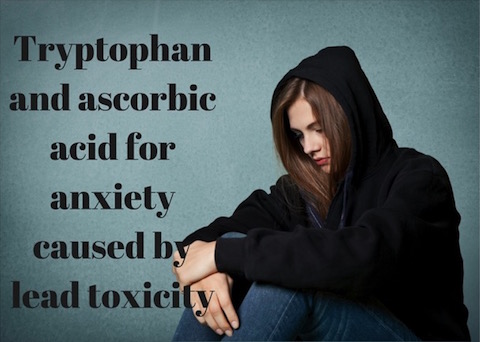
Supplemental vitamin C has many exceptional health benefits and causes no issues for a large majority of individuals. However if you have dietary oxalate issues, doses of vitamin C above 100mg to 250mg per day may be problematic and trigger pain, anxiety, insomnia, bladder issues and more. This blog, Coronavirus and vitamin C for immune support: new pain or more severe pain due to oxalate issues?, is part 1 of the series which sets the scene and is a fact-finding article. Part 2, Oxalate crystal disease, dietary oxalates and pain: the research & questions (part 2), covers the research behind oxalate crystal disease.
Today we look at some of the research on vitamin C/ascorbic acid being a possible trigger for the formation of oxalates in certain instances. This paper, No contribution of ascorbic acid to renal calcium oxalate stones, has a good summary:
Even though a certain part of oxalate in the urine derives from metabolized ascorbic acid, the intake of high doses of vitamin C does not increase the risk of calcium oxalate kidney stones due to physiological regulatory factor: gastrointestinal absorption as well as renal tubular reabsorption of ascorbic acid are saturable processes, and the metabolic transformation of ascorbic acid to oxalate is limited as well.
But in the large-scale Harvard Prospective Health Professional Follow-Up Study, those groups in the highest quintile of vitamin C intake (> 1,500 mg/day) had a lower risk of kidney stones than the groups in the lowest quintiles.
This paper does however have this precaution:
Recurrent stone formers and patients with renal failure who have a defect in ascorbic acid or oxalate metabolism should restrict daily vitamin C intakes to approximately 100 mg.
My proposed interpretation of this
I’d like to propose an interpretation of this, based on what we know about oxalates. These are the individuals who should restrict daily vitamin C intakes to approximately 100 mg per day (or up to around 250mg per day – more on the range below):
1) If you are someone who is a recurrent stone former or is in renal failure with a defect in ascorbic acid or oxalate metabolism
2) If you are someone with dietary oxalate issues i.e. you have similar symptoms when consuming vitamin C as you do when consuming high oxalate foods. Could we consider that you be classified as having “a defect in ascorbic acid or oxalate metabolism?” I would say yes.
I’ve added #2 above because we need to keep in mind that many individuals who have issues with dietary oxalates are not necessarily stone formers and nor do they have renal failure.
Research is also lacking in this area as you can read in Oxalate crystal disease, dietary oxalates and pain: the research & questions (part 2).
An omission of the 100mg per day restriction
I would like to point out that the study mentioned above was referred to in an article on Dr. Andrew Saul’s site but for some reason the section about the 100mg daily restriction was omitted from the article. It may have something to do with the fact that the author firmly believes that no-one has oxalate issues with any dose of vitamin C. In fact, he even jokingly makes this comment in the article:
Is some clown still trying to tell you that vitamin C is somehow dangerous? Or that you shouldn’t take more than 200 mg/day?
If you are someone who does experience pain when consuming vitamin C (like I do), I’m pretty sure you don’t find this comment amusing.
Vitamin C intake leading to pain, anxiety, insomnia, low mood and bladder issues
Here is some additional feedback from a question I posted on Facebook. This is the question I posted:
I’ve been sharing here about vitamin C being an issue for some folks who have oxalate issues and seeing an increase in pain. I’d love to hear if you upped your vitamin C intake for immune support and saw your mood take a dive or your anxiety increase or your sleep get worse? Vitamin C typically helps because it’s a cofactor for making neurotransmitters like serotonin and GABA and tyrosine but too much of a good thing is not good! Did you also have increased or new pain (as well as anxiety, low mood and insomnia)?
Here are some of the responses from folks who shared about pain, anxiety, insomnia, low mood and bladder issues:
- Fay shared this: “Yes increased pain, insomnia and anxiety with increased C and mouth sores to boot. Taking liposomal C and Ester C to boost antioxidants for health reasons and pain in elbows and knees. Not sleeping well at all either.”
- Lica shared this: “Yes increased anxiety…never thought of it before…felt a bug coming on and took c for a few days…yup anxiety.”
- Nicola shared this: “Increase in body pain, burning bladder, sleep affected and low mood ( not something I usually suffer with). I was taking liposomal C then increased the dose and also added Ester C as I had symptoms of covid. I was taking 1-2g a day of liposomal previously as a preventative and increased to 4g plus 4g of Ester. Only did it for a couple of days. Stopped three days ago and pain is starting to subside but no sleep last night. So I will continue with a break for now and add a very low dose again perhaps of Ester C and see how I go.”
I really appreciate these women sharing their experiences so we can all learn!
What is the upper limit of vitamin C for individuals with dietary oxalate issues?
I’m sure you’re wondering about the various dosages mentioned: the study mentions 100mg per day, Dr. Andrew Saul’s clown comment says 200mg per day and Susan Owen’s TLO Facebook group recommends no more than 250mg per day. You’ll need to figure out what the upper dose of vitamin C you can tolerate – by trial and error.
The big disconnect is always the mention of kidney stones
This is one of many similar studies on the topic of ascorbic acid/vitamin C and oxalates. There are also many studies and articles stating that vitamin C does NOT play a role in the formation of oxalates and cause kidney stones. The big disconnect is always the mention of kidney stones. The missing piece – in the research and in many articles – is that you can have issues with dietary oxalates AND vitamin C when there is no kidney disease/no kidney stones.
I have a number of additional oxalate blog posts planned so please let me know what else you want to hear about.
Here are the 2 previous blog posts on this topic of oxalates, vitamin C and pain:
- Coronavirus and vitamin C for immune support: new pain or more severe pain due to oxalate issues? (part 1)
- Oxalate crystal disease, dietary oxalates and pain: the research & questions (part 2)
Please also share your vitamin C oxalate story and how you figured it out (and if you react in a similar way to dietary oxalates).
Let us know what your ideal dose is (and which dose caused issues) and what form of vitamin C and product name you use/used. Feel free to share if you also have a history of kidney stones.
Feel free to post your questions here too.
Read all posts in this series:
- Coronavirus and vitamin C for immune support: new pain or more severe pain due to oxalate issues? (part 1)
- Oxalate crystal disease, dietary oxalates and pain: the research & questions (part 2)
- Vitamin C causes oxalate formation resulting in pain, anxiety, and insomnia (when there is a defect in ascorbic acid or oxalate metabolism)? (part 3)
- Willow’s survival story: Easter Lilies cause acute renal failure in cats and Peace Lilies cause oxalate issues (part 4)
- Waking in the night due to environmental toxins: impacts on the liver, gallbladder and fat digestion (making oxalate issues worse) (part 5)

